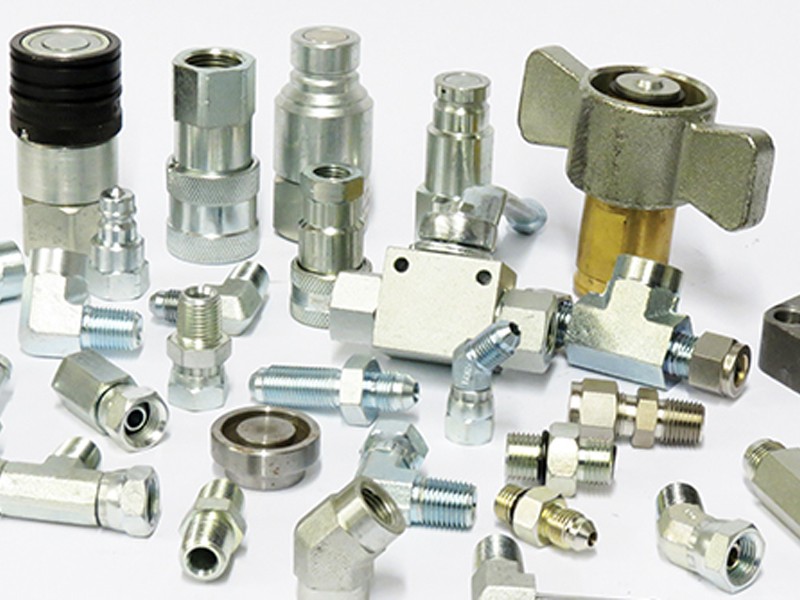Pneumatic fittings connect sections of pipe, tube and hose in pressurized gas systems. Compared to hydraulic fittings, pneumatic fittings are generally characterized by tighter seals and lower pressure requirements. They are common in pneumatic logic control systems and instrumentation. We will discuss the vessels and types of pneumatic fittings.
Pneumatic Fittings: Pipes, Tubes and Hoses
Hoses
Hoses are flexible vessels. The construction of hoses consists of multiple layers of different materials.
Since the hose itself typically requires replacement in time due to wear, fittings for hoses are usually not permanent.
Pipes
Pipes are rigid vessels. The construction of pipes consists of one solid material.
Typically, pipes are defined by their inner diameter dimension.
Tubes
Tubes are fairly rigid vessels. Construction of tube consists of one solid material.
Tubes are typically defined by their outside diameter dimension.
Types of Pneumatic Fittings
Connection Type
Numerous different connection methods attach pneumatic fittings, each with its own conveniences and advantages.
Ball and Sleeve Fittings
The ball and sleeve fittings connect the outer sleeve to the inner (ball) fitting. The outer sleeve retracts to connect and disconnect the two ends of the fitting.
Some of these fittings function as push-to-connect fittings. Therefore, they’re great for applications which require frequent disconnection and re-connection of the hose section.
Compression Fittings
All types of fittings, which use compressive force to connect the vessel to the fitting, are classified as compression fittings.
Standard Compression Fittings
These type of fittings utilize metal baskets, rings or ferrules which form a seal on the vessel through compression.
Generally, the compression consists of tightening a nut onto the fitting over the piping and ferrule. Therefore, this compresses and secures the vessel inside. Standard compression fittings do not require tools to assemble, which makes them great for quick field installations.
Bite-Type Fittings
These are compressive fittings with a sharpened ferrule that “bites” the vessel when compressed and provides the seal.
Similar to standard compression fittings, bite-type fittings require no special tools to assemble, but provide a stronger, higher pressure connection.
Mechanical Grip Fittings
Mechanical grip fittings are two-ferrule assemblies. The back ferrule grips the vessel while pressing up against the front ferrule. Therefore, this spring-loads the front ferrule and makes a seal between the piping and fitting body.
Reassembly of these fittings can happen multiple times without damaging components or piping, which is because they have great resistance to mechanical vibration.
Flare Fittings
These type of fittings have a body with a flared or coned end. Special flaring tools are necessary to install the vessel inside the flared end. Therefore, this provides a deep seal.
Compared to standard compression fittings, flared fittings can handle higher pressures and a wider range of operating parameters.
Crimp Fittings
Crimp fittings require placing hose over a tubular end and crimping against it with one of the following:
- a sleeve
- a ring
- a crimp socket
Generally, these fittings involve crimping tools or machines to make the connections.
End Fittings
Specific surfaces are provided by end fittings for connecting vessels in pneumatic systems.
Push-to-Connect Fittings
These type of fittings consist of ends that accept tubing by pushing it into the end.
Generally, these fittings disconnect via some type of collar retraction. Therefore, these connections are great for sections of the system requiring frequent disconnection and re-connection.
Threaded Fittings
Threaded fittings consist of screw threads (built-in grooves) on their inner (female) or outer (male) surfaces, which are designed to accept connections with matching threads. Straight threads are threads that provide a simple connection but no guaranteed seal.
Tapered threads provide a tight seal which is critical for pneumatic applications. These precision threads create a “dry fit”, which means they seal without the need for an additional sealant. Therefore, this is important in applications where sealant addition could cause contamination or corrosion.
Don’t hesitate to contact Bryan Hose & Gasket with the link below for more information or to purchase your pneumatic fittings today!

